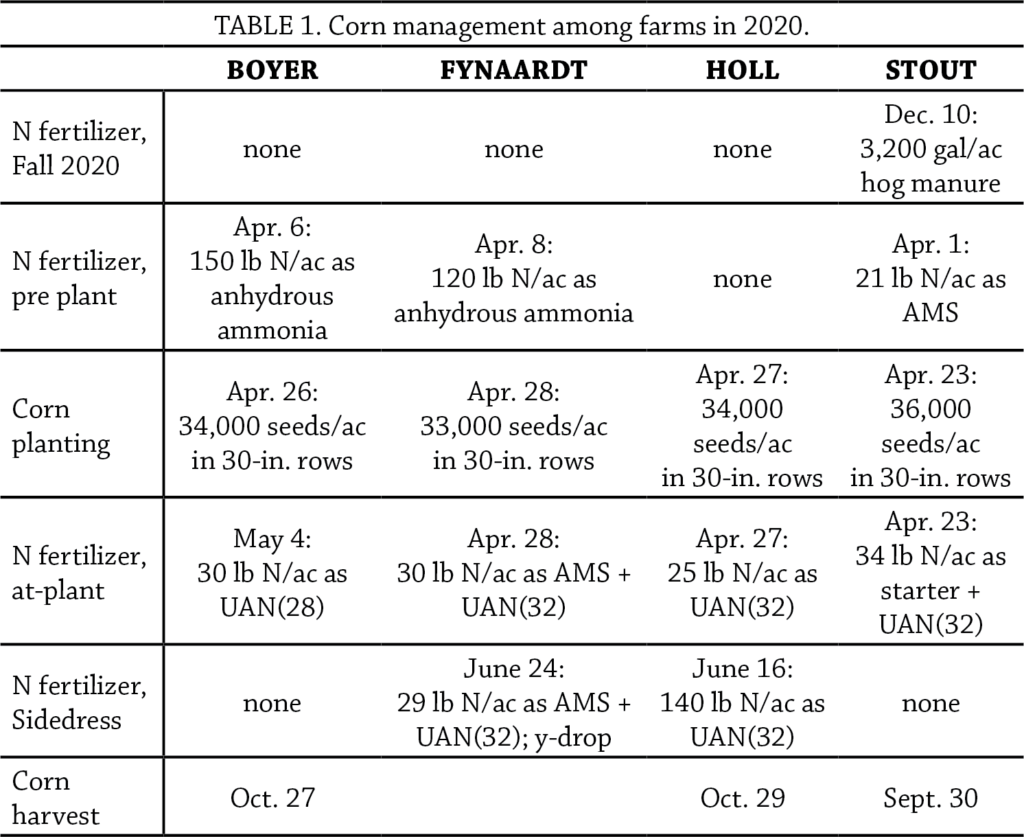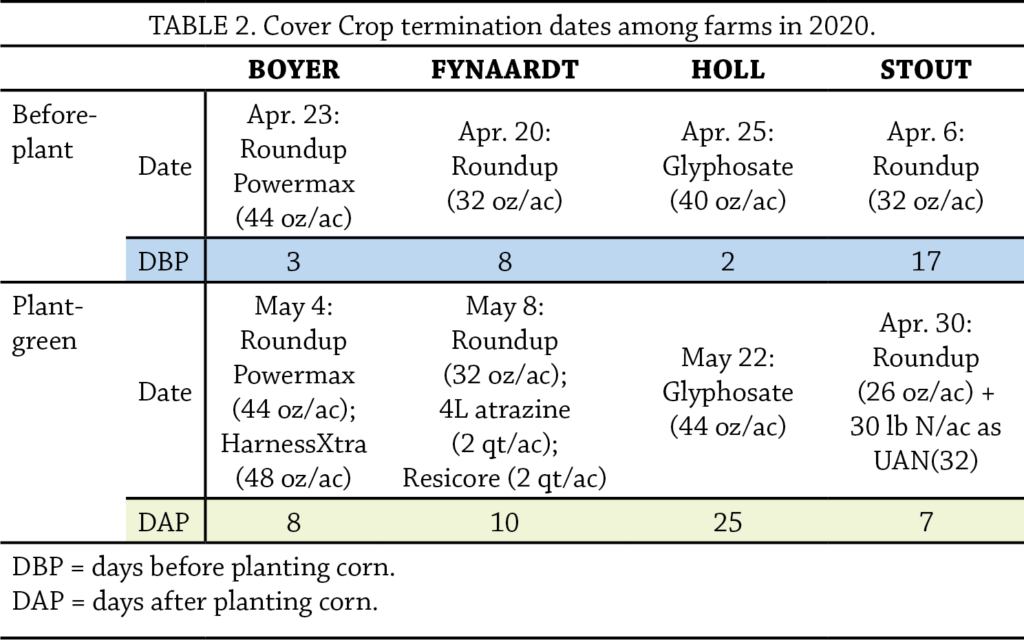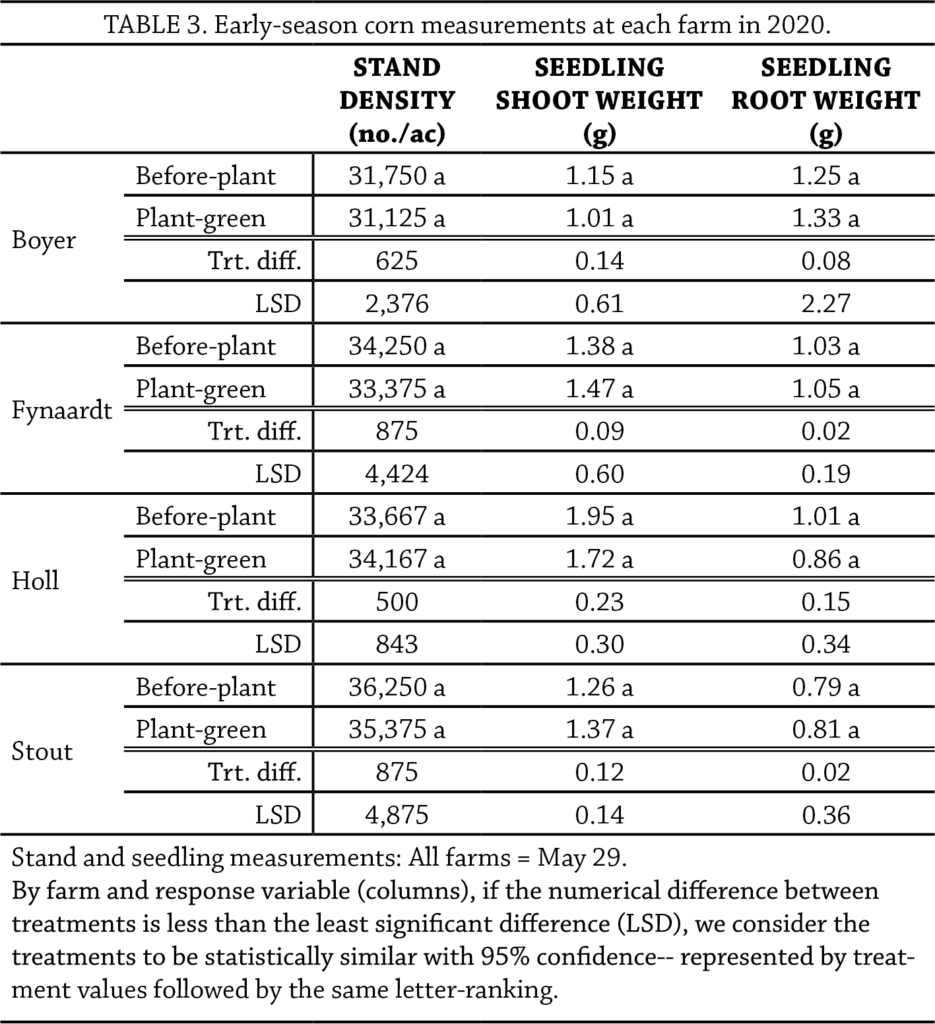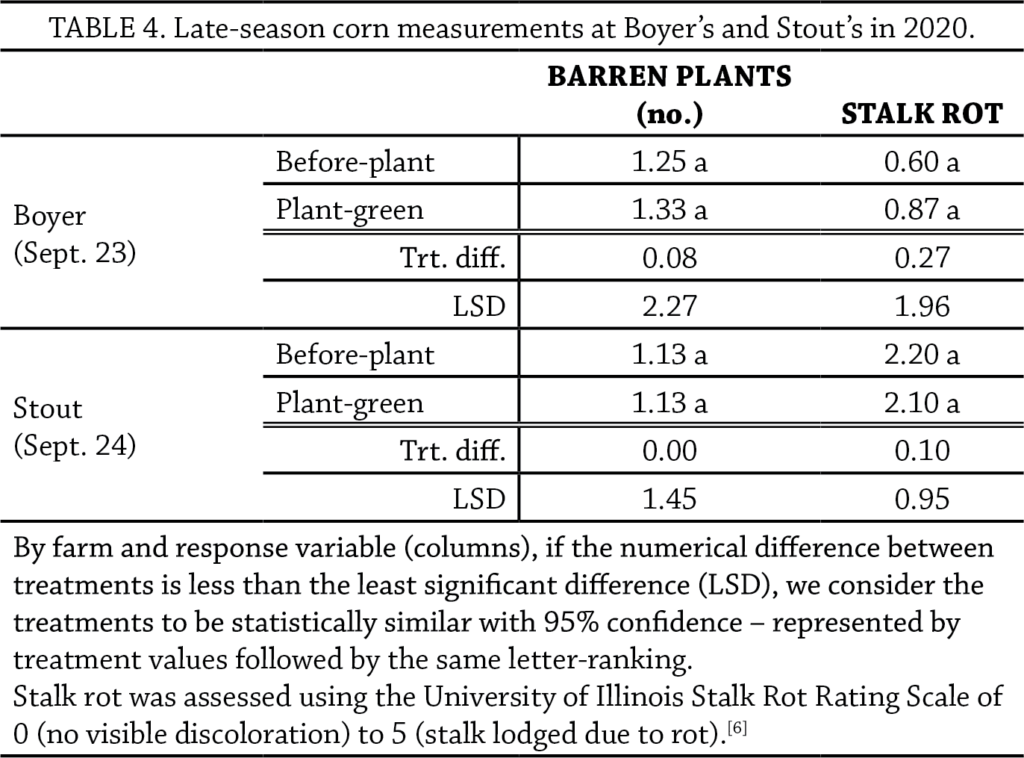Effect of Planting Green on Corn Seedling Disease, Stalk Rot and Yield
In a Nutshell:
- Jack Boyer, Eric Fynaardt, Kevin Holl and Rob Stout each conducted strip trials to test the effect of cereal rye cover crop termination date on corn disease pressure and corn yield. They each compared terminating the cover crop before planting corn to terminating the cover crop after planting corn.
Key Findings:
- Across the four farms, cover crop termination dates ranged from 2 to 17 days before planting corn (before-plant) to 7 to 25 days after planting corn (plant-green).
- At only one farm (Fynaardt’s) did we observe a negative effect on corn yield from planting green.
- Dr. Alison Robertson’s lab team from ISU Plant Pathology and Microbiology observed no effects of cover crop termination date on corn seedling disease, corn stands, number of barren plants and stalk rot at any of the farms.
Background
Most recommendations suggest terminating a cover crop at least 10 days before planting corn to avoid early-season deficiencies of soil moisture and soil N. Recent scientific evidence warns also of the potential for corn seedling disease as the time between cover crop termination and corn planting narrows.[1] On-farm strip trials by PFI cooperators between 2016 and 2018 have reported significant corn yield reductions (2 to 14%) when cover crops were terminated within two days of planting corn.[2–4] Despite recommendations and contrary to these research findings, some farmers anecdotally report no problems when planting corn soon before or soon after terminating a cover crop. (Otherwise known as planting green.) Jack Boyer, Eric Fynaardt, Kevin Holl and Rob Stout have all planted green a few times in recent years and that is why each of them participated in this project. “There has been much discussion about cereal rye before corn, and its potential problems,” Boyer said. “This trial may help understand those concerns.” Fynaardt added: “We have been planting corn green for last few years but have had no side by side comparison of early termination. [A strip trial] will provide nice information for comparison.”
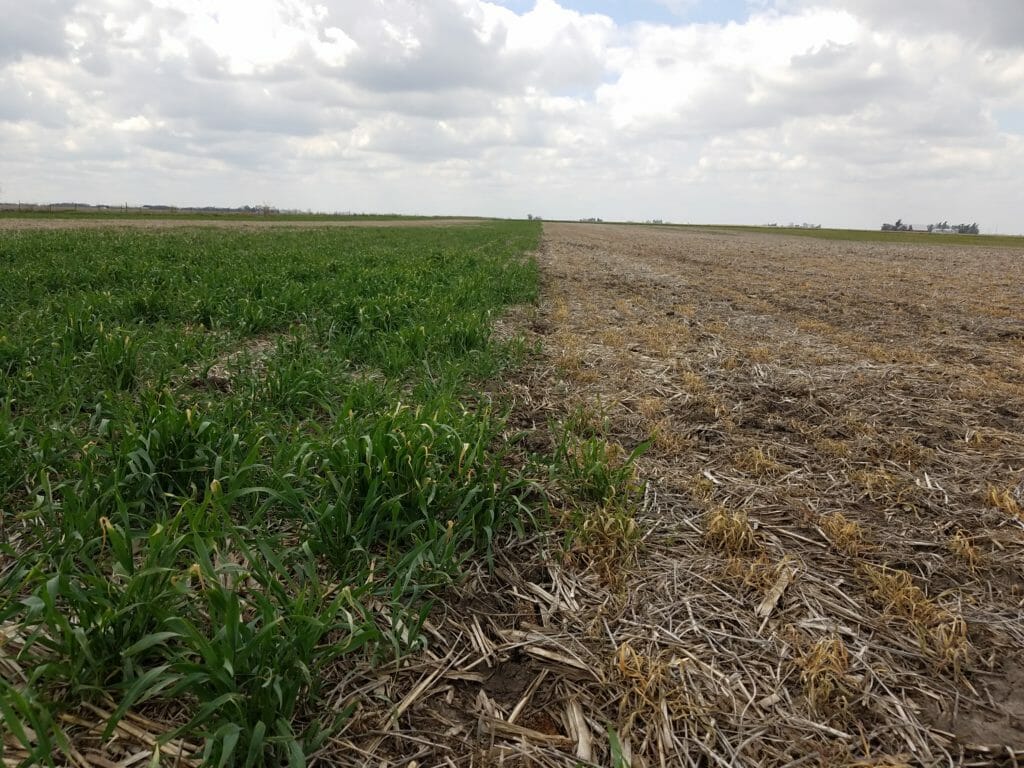
Rob Stout’s on Apr. 23, 2020; the day he planted corn. On the left is a “plant-green” strip: the cereal rye cover crop that was eventually terminated seven days later on Apr. 30. On the right is a “before-plant” strip: the cereal rye cover crop was terminated 17 days prior on Apr. 6.
Methods
Design
Each cooperator seeded a cereal rye cover crop shortly after soybean harvest in Fall 2019. Boyer drilled at 50 lb/ac on Oct. 29; Fynaardt broadcast and incorporated at 50 lb/ac on Nov. 15; Holl drilled at 90 lb/ac on Nov. 8; Stout drilled at 56 lb/ac on Oct. 29.
Each cooperator planted corn in 2020 and field management at all farms is provided in Table 1.
To test the effect of cover crop termination date on corn, each cooperator compared two treatments:
- Before-planting. Target: terminate cover crop ~18 days before planting corn
- Plant-green. Target: terminate cover crop ~6 days after planting corn.
Actual cover crop termination dates at each farm is provided in Table 2.
Each cooperator implemented at least four replications of the two treatments in randomized strips (Figure A1). Strips at each farm were as wide as at least one combine pass and ran the length of the field.
Measurements
Dr. Alison Robertson’s lab group travelled to each farm on May 29, 2020 to determine corn stand densities, corn seedling shoot weights and corn seedling root weights. The lab group assessed barren plants and stalk rot incidence at Boyer’s on Sept. 23 and Stout’s on Sept. 24. Severe lodging due a high-wind storm (derecho) in August precluded these measurements at Fynaardt’s and Holl’s.
All cooperators harvested corn from each individual strip and grain yields were corrected to 15.5% moisture.
Data analysis
To evaluate any effects of cover crop termination date, we calculated the least significant difference (LSD) at the 95% confidence level using a t-test for each measurement: corn yield, corn stand density, corn seedling shoot weight, corn seedling root weight, barren plants and stalk rot. For each measurement, if the numeric difference resulting from the two termination dates was greater than the LSD, we would expect such a difference to occur 95 times out of 100 under the same conditions – we refer to this as a statistically significant effect. On the other hand, if the numeric difference resulting from the two termination dates was less than the LSD, we considered the results statistically similar. We could make these statistical calculations because the cooperators’ experimental designs involved replication of the two cover crop termination dates (Figure A1).
Results and Discussion
Corn yield
Boyer, Holl and Stout observed no statistical differences in corn yield between the two cover crop termination dates (Figure 1). Fynaardt, on the other hand saw a 12 bu/ac decline in corn yield where he planted green compared to where he terminated the cover crop prior to planting corn. Corn yields at Boyer’s and Stout’s were above or at their respective county five-year averages (Grundy: 210 bu/ac; Washington: 203 bu/ac).[5] Corn yields at Fynaardt’s and Holl’s, however, were 10 to 20 bu/ac below their county five-year averages and likely owing to wind damage that occurred during the derecho in mid-August (Poweshiek: 209 bu/ac; Marshall: 215 bu/ac).[5]

FIGURE 1. Corn yields as aff ected by cover crop termination date at each farm in 2020. Columns represent treatment means at each farm; points represent the yield from individual strips. Asterisks (*) indicate statistical diff erences at the 95% confi dence level. NS indicates no statistical diff erence. We determined statistical signifi cance using the least signifi cant diff erence (LSD). By farm: Boyer, LSD = 12 bu/ac; Fynaardt, LSD = 9 bu/ac; Holl, LSD = 27 bu/ac; Stout, LSD = 6 bu/ac. Treatment abbreviations: BP = before-plant; PG = plant-green; DBP = days before planting corn; DAP = days after planting corn.
Previous on-farm research by PFI cooperators has documented “yield drag” when planting green, similar to what Fynaardt observed in 2020. In these previous trials, cover crop biomass levels ranged from 2,000 to 5,000 lb/ac when those farmers planted green, which represented a two- to five-fold increase in biomass compared to when cover crops were terminated at least 15 days before planting corn.[2–4] As the photos from Fynaardt’s farm on May 22 indicate, the corn that was planted green emerged through far more cover crop residue; that early-season competition may have slowed corn seedling development and ultimately resulted in the statistical yield reduction.
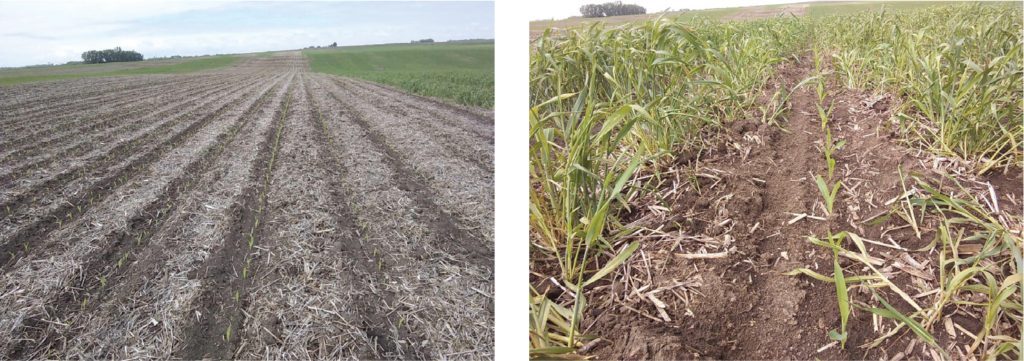
Corn emerging at Eric Fynaardt’s farm on May 22, 2020. At left, the cereal rye cover crop was terminated on Apr. 20 (before-plant treatment). At right, the cereal rye cover crop was terminated on May 8 (plant-green treatment). Corn was planted on Apr. 28.
All four farmers applied at least 25 lb N/ac near the time of corn planting (Table 1). This practice is intended to alleviate early-season soil N depletion by a cover crop that can hamper corn seedling development. At Boyer’s (the only farm at which cover crop biomass samples were collected), he observed only 43 lb/ac in the before-plant treatment and 112 lb/ac in the plant-green treatment. This relatively low amount of cover crop growth may have been one reason why Boyer did not observe yield differences between the two termination dates. At Fynaardt’s, it could be that the amount of cover crop growth that occurred in the plant-green treatment was too much to overcome despite applying N at planting.
Seedling measurements
In late May, Dr. Robertson’s lab group observed no effect of the cover crop termination date on corn stand density, corn seedling shoot weight and corn seedling root weight at each of the four farms (Table 3).
Ear and stalk measurements
Dr. Robertson’s lab group returned to the farms in September to assess barren corn plants and stalk rot. They were only able to make these observations at Boyer’s and Stout’s because wind damage from a derecho in August made sampling too difficult at Fynaardt’s and Holl’s (e.g., field were inaccessible due to bent, “goose-necked” corn stalks).
At Boyer’s and Stout’s, there were no effects of cover crop termination date on the number of barren plants or signs of stalk rot (Table 4).
Previous research in Iowa by Dr. Robertson’s lab linked planting green to reduced corn stands, increased number of barren plants and reduced corn yields.[1] They attributed these findings to increased levels of seedling disease compared to where the cover crop was terminated at least 10 to 14 days prior to planting corn. According to Dr. Robertson, yearly and season variation as well as crop management can influence the prevalence of crop pathogens (such as Pythium and Fusarium species that cause seedling disease in corn). In the present study, conditions at the four farms may not have been suitable for corn seedling disease pathogens regardless of cover crop termination date.
Conclusions and Next Steps
Contrary to conventional wisdom and to previous on-farm research results, the majority of the farms reported no negative effect on corn yield when planting green compared to terminating the cover crop before planting corn. Because each of the cooperators had some experience planting green in the past, they valued this experimental experience that was designed to shed more light on the practice. Boyer and Stout were glad to see that planting green at their farms did not result in yield drag; both are keen to allow a cover crop to grow as long as possible in the spring (up until corn planting) in order to maximize soil health benefits. Holl was happy to learn more about cover crop management ahead of field corn on his farm because he had some challenges previously when raising seed corn after a cover crop. “The commercial corn planted into a rye cover crop went very well and I’m willing to do it again,” Holl added. Each cooperator will be repeating the trial in 2021 and in partnership once again with Dr. Robertson’s lab group.
Appendix – Trial Design and Weather Conditions
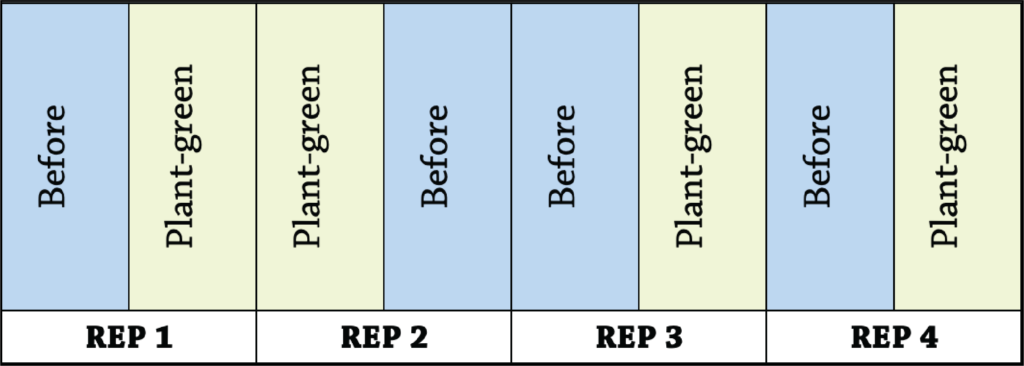
FIGURE A1. Sample experimental design used by the cooperators. The design includes replications of the two cover crop termination date treatments. This design allowed for statistical analysis of the results.
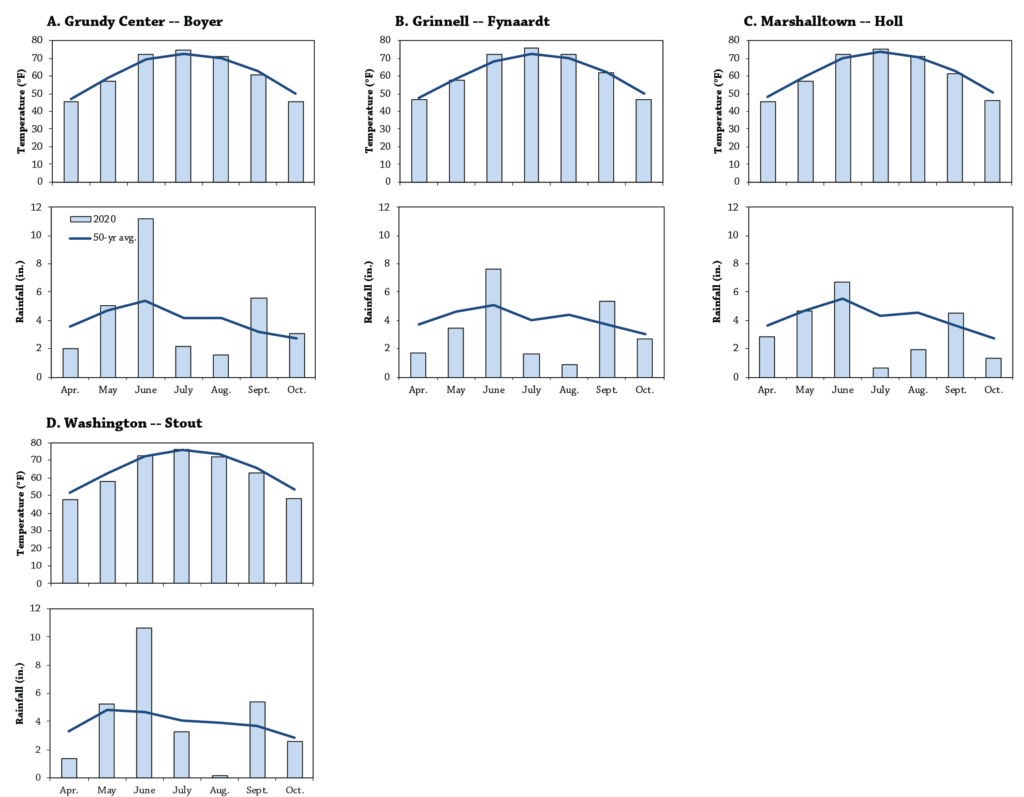
FIGURE A2. Mean monthly temperature and rainfall for 2020 and the long-term averages at the nearest weather stations to each farm.[7] A) Grundy Center (Boyer); B) Grinnell (Fynaardt); C) Marshalltown (Holl); D) Washington (Stout).
Funding Acknowledgement
This material is based upon work supported by the Agriculture and Food Research Initiative of the National Institute of Food and Agriculture, U.S. Department of Agriculture, under 2019-68008-29909 subaward number 021155. Any opinions, findings, conclusions, or recommendations expressed in this publication are those of the author(s) and do not necessarily reflect the views of the U.S. Department of Agriculture.
References
- Acharya, J., M.G. Bakker, T.B. Moorman, T.C. Kaspar, A.W. Lenssen and A.E. Robertson. 2016. Time Interval Between Cover Crop Termination and Planting Influences Corn Seedling Disease, Plant Growth, and Yield. Plant Disease. 101:591–600. https://apsjournals.apsnet.org/doi/pdfplus/10.1094/PDIS-07-16-0975-RE (accessed February 2021).
- Gailans, S. and D. Sloan. 2016. Cover Crop Termination Date Ahead of Corn. Practical Farmers of Iowa Cooperators’ Program. https://practicalfarmers.org/wp-content/uploads/2018/10/16.FC_.CC.Cover_Crop_Termination_Date_Corn.pdf (accessed February 2021).
- Gailans, S., D. Sloan and T. Sieren. 2017. N Fertilizer Strategies for Corn Following Cover Crop. Practical Farmers of Iowa Cooperators’ Program. https://practicalfarmers.org/wp-content/uploads/2018/10/17.FC_.CC.N-fert-strategies-for-corn-after-cover.compressed.pdf (accessed February 2021).
- Gailans, S. and A. Kauffman. 2018. Cereal Rye Cover Crop Termination Date Before Corn. Practical Farmers of Iowa Cooperators’ Program. https://practicalfarmers.org/research/cereal-rye-cover-crop-termination-date-before-corn/ (accessed February 2021).
- US Department of Agriculture-National Agricultural Statistics Service. Quick stats. USDA-National Agricultural Statistics Service. https://quickstats.nass.usda.gov/ (accessed February 2021).
- Hines, R., J. Shaw, I. Natural, H. Survey and D. White. 2011. University of Illinois (0-5) Stalk Rot Rating Scale. https://fyi.extension.wisc.edu/fieldcroppathology/files/2011/03/stalkrotscale.pdf (accessed February 2021).
- Iowa Environmental Mesonet. 2020. Climodat Reports. Iowa State University. http://mesonet.agron.iastate.edu/climodat/ (accessed January 2021).


